中国全科医学 ›› 2023, Vol. 26 ›› Issue (21): 2647-2658.DOI: 10.12114/j.issn.1007-9572.2022.0627
收稿日期:2022-06-01
修回日期:2022-09-19
出版日期:2023-07-20
发布日期:2022-11-24
通讯作者:
翟巾帼
基金资助:
WANG Xueyan1, TIAN Jinhui2, ZHANG Li3, ZHAI Jinguo1,*( )
)
Received:2022-06-01
Revised:2022-09-19
Published:2023-07-20
Online:2022-11-24
Contact:
ZHAI Jinguo
摘要: 背景 胎儿臀位和横位如未得到及时、有效处理可能会增加剖宫产率,且增加子宫破裂等严重分娩并发症的风险,危及母胎生命。然而,对于不同干预措施的有效性对比与选择的优先次序,目前尚无统一结论。 目的 采用网状Meta分析方法,评价不同干预措施对孕晚期胎儿臀位/横位孕妇母婴结局的影响。 方法 计算机检索Cochrane Library、PubMed、Web of Science、Embase、CINAHL、中国生物医学文献数据库(CBM)、中国知网(CNKI)、维普网(VIP)、万方数据知识服务平台中关于不同干预措施对孕晚期胎儿臀位/横位孕妇母婴结局影响的随机对照试验(RCT),检索时间为建库至2022年3月。由2名研究人员独立完成文献筛选和资料提取,并进行文献质量评价。采用R 4.1.1和Stata 16.0软件进行数据分析和图形绘制,首先进行一致性检验与收敛性评估;通过累积排序概率图下面积(SUCRA)呈现不同措施成为最佳干预措施的可能。 结果 本研究共纳入36篇文献,包含7 419名产妇。涉及的干预措施有:膝胸卧位、艾灸/刺激至阴穴和不同类型宫缩抑制剂/麻醉方式下实施外倒转术(ECV)。网状Meta分析结果显示,常规护理胎儿转为头位成功率低于艾灸/刺激至阴穴〔RR=0.54,95%CI(0.32,0.86),P<0.05〕;无宫缩抑制剂胎儿转为头位成功率低于使用β2肾上腺素受体激动剂〔RR=0.60,95%CI(0.38,0.62),P<0.05〕;无宫缩抑制剂、使用钙通道阻滞剂的阴道分娩率低于使用β2肾上腺素受体激动剂〔RR=0.60,95%CI(0.39,0.89),P<0.05;RR=0.60,95%CI(0.39,0.95),P<0.05〕;ECV时无麻醉的胎儿转为头位成功率低于使用静脉麻醉〔RR=0.71,95%CI(0.53,0.96),P<0.05〕和椎管内麻醉〔RR=0.65,95%CI(0.49,0.85),P<0.05〕;静脉麻醉、椎管内麻醉与不麻醉相比,可降低ECV后疼痛评分〔WMD=-1.97,95%CI(-2.49,-1.46),P<0.05;WMD=-3.80,95%CI(-5.10,-2.50),P<0.05〕。SUCRA排序结果显示,艾灸/刺激至阴穴、使用β2肾上腺素受体激动剂抑制宫缩、在椎管内麻醉下实施ECV是孕晚期纠正胎儿臀位/横位的较优措施。 结论 基于网状Meta分析结果和排序结果,艾灸/刺激至阴穴、使用β2肾上腺素受体激动剂抑制宫缩和在椎管内麻醉下实施ECV等措施对改善孕晚期胎儿臀位/横位孕妇母婴结局效果较好,但仍需高质量、大样本的研究进一步验证。
| 步骤 | 检索式 |
|---|---|
| #1 | breech presentation[MeSH] OR breech presentation[Title/Abstract] OR presentation breech[Title/Abstract] OR breech fetal[Title/Abstract] OR incomplete breech[Title/Abstract] OR complete breech[Title/Abstract] OR frank breech[Title/Abstract] OR transverse lie[Title/Abstract] OR labor presentation[Title/Abstract] |
| #2 | posture[MeSH] OR posture*[Title/Abstract] OR position[Title/Abstract] OR knee*[Title/Abstract] OR hand*[Title/Abstract] OR sims[Title/Abstract] OR stand*[Title/Abstract] OR squat*[Title/Abstract] OR seat*[Title/Abstract] OR upright[Title/Abstract] OR waist[Title/Abstract] OR knee-chest[Title/Abstract] OR breath*[Title/Abstract] OR delivery ball[Title/Abstract] OR birth ball[Title/Abstract] |
| #3 | acupuncture[MeSH] OR moxibustion[Title/Abstract] OR acupuncture[Title/Abstract] OR zhiyin[Title/Abstract] OR BL 67[Title/Abstract] |
| #4 | "version,fetal" [MeSH] OR "version,fetal" [Title/Abstract] OR external cephalic version[Title/Abstract] OR pelvic rotation[Title/Abstract] OR external[Title/Abstract] OR reversal[Title/Abstract] |
| #5 | #2 OR #3 OR #4 |
| #6 | Randomized Controlled Trials as Topic[MeSH] OR Randomized Controlled Trial[Publication Type] OR Randomized Controlled Trial[Title/Abstract] OR RCT[Title/Abstract] |
| #7 | #1 AND #5 AND #6 |
表1 PubMed检索策略
Table 1 Strategy for searching RCTs of the effects of different interventions for breech or transverse lie position on maternal and neonatal outcomes in PubMed database
| 步骤 | 检索式 |
|---|---|
| #1 | breech presentation[MeSH] OR breech presentation[Title/Abstract] OR presentation breech[Title/Abstract] OR breech fetal[Title/Abstract] OR incomplete breech[Title/Abstract] OR complete breech[Title/Abstract] OR frank breech[Title/Abstract] OR transverse lie[Title/Abstract] OR labor presentation[Title/Abstract] |
| #2 | posture[MeSH] OR posture*[Title/Abstract] OR position[Title/Abstract] OR knee*[Title/Abstract] OR hand*[Title/Abstract] OR sims[Title/Abstract] OR stand*[Title/Abstract] OR squat*[Title/Abstract] OR seat*[Title/Abstract] OR upright[Title/Abstract] OR waist[Title/Abstract] OR knee-chest[Title/Abstract] OR breath*[Title/Abstract] OR delivery ball[Title/Abstract] OR birth ball[Title/Abstract] |
| #3 | acupuncture[MeSH] OR moxibustion[Title/Abstract] OR acupuncture[Title/Abstract] OR zhiyin[Title/Abstract] OR BL 67[Title/Abstract] |
| #4 | "version,fetal" [MeSH] OR "version,fetal" [Title/Abstract] OR external cephalic version[Title/Abstract] OR pelvic rotation[Title/Abstract] OR external[Title/Abstract] OR reversal[Title/Abstract] |
| #5 | #2 OR #3 OR #4 |
| #6 | Randomized Controlled Trials as Topic[MeSH] OR Randomized Controlled Trial[Publication Type] OR Randomized Controlled Trial[Title/Abstract] OR RCT[Title/Abstract] |
| #7 | #1 AND #5 AND #6 |
| 第一作者 | 发表时间(年) | 国家 | 样本量(T/C) | 年龄(T/C) (岁) | 孕周(T/C) (周) | 孕产次(T/C) | 干预措施 | 结局指标 |
|---|---|---|---|---|---|---|---|---|
| 彭朝梨[ | 2021 | 中国 | 192/192 | 31.5±2.2/31.3±2.2 | 38.7±0.8/38.4±0.8 | 初产妇:121/124;经产妇:71/68 | T:硫酸特布他林抑制宫缩,硬膜外麻醉下实施ECV;C:膝胸卧位,2次/d,10~15 min/次,干预时长为1周 | ①② |
| 唐小媚[ | 2020 | 中国 | 30/30 | 29.3±2.3/29.3±2.3 | 39.0±0.2/39.0±0.2 | 初产妇:20/22;经产妇:10/8 | T:硫酸特布他林抑制宫缩,硬膜外麻醉下实施ECV;C:膝胸卧位,2次/d,10~15 min/次,干预时长为1周 | ①② |
| 林岸芸[ | 2020 | 中国 | 80/80 | 29.0±3.5/30.0±3.7 | 30.0~32.0 | 未提及 | T:分娩球运动,3~4次/周;C:膝胸卧位,2次/d,15 min/次 | ①② |
| 廖琪[ | 2018 | 中国 | 100/100 | 26.6±4.3/26.3±4.5 | 31.7±1.6/31.4±1.5 | 未提及 | T:艾条悬灸至阴穴30 min,灸毕行膝胸卧位15 min,2次/d;C:行膝胸卧位15 min,2次/d,为期2周 | ①② |
| HAMIDZADEH[ | 2022 | 伊朗 | 69/69 | 24.9±2.4/24.7±2.7 | 33.1±1.1/32.9±1.10 | 初产妇:44/40;经产妇:25/29 | T:按压至阴穴,10 min/次,为期2周;C:接受常规护理 | ①②③ |
| DOCHEZ[ | 2020 | 法国 | 74/76 | 32.9±5.6/31.0±4.6 | >36.0 | 初产妇:40/42;经产妇:34/34 | T:吸入一氧化二氮之后实施ECV;C:吸入医用空气之后实施ECV | ①②③④ |
| SOURANI[ | 2020 | 伊朗 | 32/32 | 28.1±4.5/30.7±7.0 | 39.0±1.9/38.4±1.3 | 初产妇:16/17;经产妇:16/15 | T:塑料夹对至阴穴进行刺激,20 min/次,2次/d,为期2周;C:不进行穴位刺激 | ①② |
| ZOBBI[ | 2017 | 意大利 | 82/82 | 31.2±5.1/31.6±4.9 | >37.0 | 初产妇:61/21;经产妇:61/21 | T:在实施ECV前2 h喝2 000 mL水;C:在实施ECV前2 h喝水不超过100 mL | ① |
| WANG[ | 2017 | 中国 | 72/72 | 33.2±4.6/32.9±5.1 | 37.0~41.0 | 初产妇:41/37;经产妇:31/35 | T:瑞芬太尼静脉镇痛后实施ECV;C:静脉使用安慰剂后实施ECV | ①②④ |
| VELZEL[ | 2017 | 荷兰 | 416/414 | 32.1±4.0/32.4±4.3 | 35.8±0.9/35.9±1.0 | 初产妇:256/255;经产妇:154/153 | T:阿托西班抑制宫缩后实施ECV;C:非诺特罗抑制宫缩后实施ECV | ①②③ |
| SANANES[ | 2016 | 法国 | 130/129 | 30.5±4.6/30.4±4.6 | 33.7±0.8/33.6±0.8 | 初产妇:71/80;经产妇:59/49 | T:针灸至阴穴,并用打火机加热针尖,30 min/次,治疗3次;C:针灸厉兑穴,并用打火机加热针尖,30 min/次,治疗3次 | ①②③ |
| LIU[ | 2016 | 中国 | 76/76 | 34.1±4.2/33.8±3.9 | 37.0~41.0 | 初产妇:45/42;经产妇:31/34 | T:瑞芬太尼静脉镇痛后实施ECV;C:静脉使用安慰剂(0.9%氯化钠溶液)后实施ECV | ①②④ |
| BURGOS[ | 2016 | 西班牙 | 60/60 | 34.8±4.0/35.1±5.0 | 37.0~41.0 | 初产妇:40/42;经产妇:20/18 | T:瑞芬太尼静脉镇痛后实施ECV;C:吸入使用一氧化二氮后实施ECV | ①② |
| VALLIKKANNU [ | 2014 | 马来西亚 | 48/47 | 31.1±4.5/29.5±4.0 | 37.5(37.4~37.9)/37.8(37.4~38.2) | 初产妇:19/27;经产妇:29/20 | T:在孕妇腹部使用滑石粉后实施ECV;C:在孕妇腹部使用凝胶后实施ECV | ①②③④ |
| COULON[ | 2014 | 法国 | 164/164 | 30.2±4.8/30.7±4.4 | 34.5±0.6/34.5±0.6 | 初产妇:95/92;经产妇:69/72 | T:艾灸与针灸至阴穴,20 min/次;C:灭活激光照射至阴穴,20 min/次,共6次,在48 h内完成 | ①②③ |
| MUÑOZ[ | 2014 | 西班牙 | 31/29 | 32.9±4.9/32.5±5.7 | 36.0~41.0 | 初产妇:18/16;经产妇:13/12 | T:瑞芬太尼静脉镇痛后实施ECV;C:静脉使用安慰剂(0.9%氯化钠溶液)后实施ECV | ①②④ |
| VAS[ | 2013 | 西班牙 | 136/136/134 | 31.5(22.6~39.0)/32.0(24.4~38.0)/31.0(24.0~38.3) | 34.0(33.0~35.0) | 初产妇:73/77/81;经产妇:63/59/53 | T1:艾灸至阴穴加常规护理,20 min/次,1次/d,为期2周;T2:艾灸隐白穴加常规护理,20 min/次,1次/d,为期2周;C:接受常规护理 | ①②③ |
| HUTTON[ | 2011 | 多国 | 767/774 | 30.0(18.9~39.2)/30.0(19.8~39.2) | 34.7(33.1~35.7)/34.9(33.3~35.7) | 初产妇:409/411;经产妇:358/363 | T:未足月(34~36周)实施ECV;C:足月(37~38周)实施ECV | ①②③ |
| DO[ | 2011 | 澳大利亚 | 10/10 | 30.4±3.1/24.6±5.2 | 34.8±0.7/35.6±0.7 | 初产妇:7/9;经产妇:3/1 | T:艾灸至阴穴,20 min/次,2次/d,为期10 d;C:常规护理干预 | ①②③ |
| WEINIGER[ | 2010 | 以色列 | 31/33 | 28.5(21.0~40.0)/28.6(20.0~36.0) | 38.1±0.9/38.2±1.1 | 初产妇:13/21;经产妇:18/12 | T:布比卡因椎管内麻醉(腰麻)后实施ECV;C:无镇痛实施ECV | ①②④ |
| VANI[ | 2009 | 马来西亚 | 57/57 | 28.2±4.8/28.7±4.3 | 38.0±0.6/38.0±0.7 | 初产妇:31/27;经产妇:26/30 | T:静脉推注宫缩抑制剂沙丁胺醇后实施ECV;C:实施ECV前不使用宫缩抑制剂 | ①② |
| HILTON[ | 2009 | 加拿大 | 65/61 | 初产妇:30.0±5.0/29.0±4.0;经产妇:31.0±5.0/32.0±5.0 | 初产妇:37.0±0.7/37.7±0.7;经产妇:37.7±0.7/37.6±0.4 | 初产妇:42/40;经产妇:23/21 | T:接受静脉推注宫缩抑制剂硝酸甘油后实施ECV;C:实施ECV前不使用宫缩抑制剂 | ①②③ |
| GUITTIER[ | 2009 | 瑞士 | 106/106 | 32.0±4.3/32.0±4.2 | 35.0±0.8/34.8±0.7 | 初产妇:75/64;经产妇:31/42 | T:艾灸至阴穴,20 min/次,3次/周,为期2周;C:只接受常规护理 | ①②③ |
| COLLARIS[ | 2009 | 马来西亚 | 44/46 | 30.0±5.0/30.0±5.0 | 38.0±1.0/38.0±1.0 | 初产妇:23/25;经产妇:21/21 | T:口服宫缩抑制剂硝苯地平后实施ECV;C:皮下注射特布他林宫缩抑制剂后实施ECV | ①②③ |
| MOHAMED ISMAIL[ | 2008 | 马来西亚 | 43/43 | 28.5±4.1/29.9±5.2 | 37.8±0.8/37.5±0.4 | 初产妇:18/21;经产妇:25/22 | T:口服宫缩抑制剂硝苯地平后实施ECV;C:静脉注射特布他林宫缩抑制剂后实施ECV | ①② |
| KOK[ | 2008 | 荷兰 | 154/156 | 33.6±4.2/34.1±4.5 | 37.0±0.8/37.0±0.9 | 初产妇:78/83;经产妇:76/73 | T:口服宫缩抑制剂硝苯地平后实施ECV;C:实施ECV前不使用宫缩抑制剂 | ①②③ |
| FOUNDS[ | 2006 | 美国 | 14/11 | 未提及 | 34.0~38.0 | 初产妇:9/4;经产妇:5/7 | T:膝胸卧位,15 min/次,3次/d,干预时长为1周;C:常规护理干预 | ①②③ |
| NOR AZLIN[ | 2005 | 马来西亚 | 30/30 | 29.1±4.5/27.5±4.3 | >37.0 | 初产妇:22/23;经产妇:8/7 | T:静脉滴注宫缩抑制剂盐酸利托君后实施ECV;C:实施ECV前不使用宫缩抑制剂 | ①②③ |
| EL-SAYED[ | 2004 | 美国 | 30/29 | 31.1±5.6/31.7±4.8 | 38.4±0.7/38.4±0.8 | 初产妇:17/18;经产妇:13/11 | T:静脉注射宫缩抑制剂硝酸甘油后实施ECV;C:皮下注射特布他林宫缩抑制剂后实施ECV | ①② |
| MANCUSO[ | 2000 | 美国 | 54/54 | 28.5±4.8/28.2±4.8 | 38.1±1.2/37.9±1.0 | 初产妇:30/29;经产妇:24/25 | T:利多卡因和芬太尼椎管内麻醉(硬膜外麻醉)后实施ECV;C:无镇痛实施ECV | ①②③ |
| SMITH[ | 1999 | 澳大利亚 | 51/49 | 29.1±4.0/29.2±5.0 | 36.5±0.6/37.0±0.5 | 初产妇:27/30;经产妇:24/19 | T:指导其采取膝胸卧位,15 min/次,3次/d,干预时长为1周;C:常规护理干预 | ①②③ |
| DUGOFF[ | 1999 | 美国 | 50/52 | 24.3±0.9/26.8±0.9 | 38.0±0.2/38.0±0.2 | 未提及 | T:舒芬太尼和布比卡因椎管内麻醉(腰麻)后实施ECV;C:无镇痛实施ECV | ①②③ |
| CARDINI[ | 1998 | 中国 | 130/130 | 25.5±2.5/25.2±3.0 | 33.0 | 未提及 | T:艾灸至阴穴,30 min/次,1~2次/d,为期1~2周;C:常规护理干预 | ①②③ |
| SCHORR[ | 1997 | 美国 | 35/34 | 27.7±6.1/25.8±6.6 | 38.0±2.3/37.4±2.1 | 初产妇:14/16;经产妇:21/18 | T:利多卡因和肾上腺素椎管内麻醉(硬膜外麻醉)后实施ECV;C:无镇痛实施ECV | ①② |
| MARQUETTE[ | 1996 | 加拿大 | 138/145 | 28.5±0.4/29.3±0.4 | 37.4±0.1/37.3±0.1 | 初产妇:58/49;经产妇:80/96 | T:静脉注射宫缩抑制剂利托君后实施ECV;C:静脉注射安慰剂后实施ECV | ① |
| CHENIA[ | 1987 | 津巴布韦 | 39/37 | 25.4±6.0/26.8±6.2 | 38.2±1.6/38.6±1.9 | 初产妇:11/4;经产妇:28/33 | T:膝胸卧位,15 min/次,3次/d,干预时长为1周;C:常规护理干预 | ①②③ |
表2 纳入文献的基本特征
Table 2 Basic characteristics of included literature
| 第一作者 | 发表时间(年) | 国家 | 样本量(T/C) | 年龄(T/C) (岁) | 孕周(T/C) (周) | 孕产次(T/C) | 干预措施 | 结局指标 |
|---|---|---|---|---|---|---|---|---|
| 彭朝梨[ | 2021 | 中国 | 192/192 | 31.5±2.2/31.3±2.2 | 38.7±0.8/38.4±0.8 | 初产妇:121/124;经产妇:71/68 | T:硫酸特布他林抑制宫缩,硬膜外麻醉下实施ECV;C:膝胸卧位,2次/d,10~15 min/次,干预时长为1周 | ①② |
| 唐小媚[ | 2020 | 中国 | 30/30 | 29.3±2.3/29.3±2.3 | 39.0±0.2/39.0±0.2 | 初产妇:20/22;经产妇:10/8 | T:硫酸特布他林抑制宫缩,硬膜外麻醉下实施ECV;C:膝胸卧位,2次/d,10~15 min/次,干预时长为1周 | ①② |
| 林岸芸[ | 2020 | 中国 | 80/80 | 29.0±3.5/30.0±3.7 | 30.0~32.0 | 未提及 | T:分娩球运动,3~4次/周;C:膝胸卧位,2次/d,15 min/次 | ①② |
| 廖琪[ | 2018 | 中国 | 100/100 | 26.6±4.3/26.3±4.5 | 31.7±1.6/31.4±1.5 | 未提及 | T:艾条悬灸至阴穴30 min,灸毕行膝胸卧位15 min,2次/d;C:行膝胸卧位15 min,2次/d,为期2周 | ①② |
| HAMIDZADEH[ | 2022 | 伊朗 | 69/69 | 24.9±2.4/24.7±2.7 | 33.1±1.1/32.9±1.10 | 初产妇:44/40;经产妇:25/29 | T:按压至阴穴,10 min/次,为期2周;C:接受常规护理 | ①②③ |
| DOCHEZ[ | 2020 | 法国 | 74/76 | 32.9±5.6/31.0±4.6 | >36.0 | 初产妇:40/42;经产妇:34/34 | T:吸入一氧化二氮之后实施ECV;C:吸入医用空气之后实施ECV | ①②③④ |
| SOURANI[ | 2020 | 伊朗 | 32/32 | 28.1±4.5/30.7±7.0 | 39.0±1.9/38.4±1.3 | 初产妇:16/17;经产妇:16/15 | T:塑料夹对至阴穴进行刺激,20 min/次,2次/d,为期2周;C:不进行穴位刺激 | ①② |
| ZOBBI[ | 2017 | 意大利 | 82/82 | 31.2±5.1/31.6±4.9 | >37.0 | 初产妇:61/21;经产妇:61/21 | T:在实施ECV前2 h喝2 000 mL水;C:在实施ECV前2 h喝水不超过100 mL | ① |
| WANG[ | 2017 | 中国 | 72/72 | 33.2±4.6/32.9±5.1 | 37.0~41.0 | 初产妇:41/37;经产妇:31/35 | T:瑞芬太尼静脉镇痛后实施ECV;C:静脉使用安慰剂后实施ECV | ①②④ |
| VELZEL[ | 2017 | 荷兰 | 416/414 | 32.1±4.0/32.4±4.3 | 35.8±0.9/35.9±1.0 | 初产妇:256/255;经产妇:154/153 | T:阿托西班抑制宫缩后实施ECV;C:非诺特罗抑制宫缩后实施ECV | ①②③ |
| SANANES[ | 2016 | 法国 | 130/129 | 30.5±4.6/30.4±4.6 | 33.7±0.8/33.6±0.8 | 初产妇:71/80;经产妇:59/49 | T:针灸至阴穴,并用打火机加热针尖,30 min/次,治疗3次;C:针灸厉兑穴,并用打火机加热针尖,30 min/次,治疗3次 | ①②③ |
| LIU[ | 2016 | 中国 | 76/76 | 34.1±4.2/33.8±3.9 | 37.0~41.0 | 初产妇:45/42;经产妇:31/34 | T:瑞芬太尼静脉镇痛后实施ECV;C:静脉使用安慰剂(0.9%氯化钠溶液)后实施ECV | ①②④ |
| BURGOS[ | 2016 | 西班牙 | 60/60 | 34.8±4.0/35.1±5.0 | 37.0~41.0 | 初产妇:40/42;经产妇:20/18 | T:瑞芬太尼静脉镇痛后实施ECV;C:吸入使用一氧化二氮后实施ECV | ①② |
| VALLIKKANNU [ | 2014 | 马来西亚 | 48/47 | 31.1±4.5/29.5±4.0 | 37.5(37.4~37.9)/37.8(37.4~38.2) | 初产妇:19/27;经产妇:29/20 | T:在孕妇腹部使用滑石粉后实施ECV;C:在孕妇腹部使用凝胶后实施ECV | ①②③④ |
| COULON[ | 2014 | 法国 | 164/164 | 30.2±4.8/30.7±4.4 | 34.5±0.6/34.5±0.6 | 初产妇:95/92;经产妇:69/72 | T:艾灸与针灸至阴穴,20 min/次;C:灭活激光照射至阴穴,20 min/次,共6次,在48 h内完成 | ①②③ |
| MUÑOZ[ | 2014 | 西班牙 | 31/29 | 32.9±4.9/32.5±5.7 | 36.0~41.0 | 初产妇:18/16;经产妇:13/12 | T:瑞芬太尼静脉镇痛后实施ECV;C:静脉使用安慰剂(0.9%氯化钠溶液)后实施ECV | ①②④ |
| VAS[ | 2013 | 西班牙 | 136/136/134 | 31.5(22.6~39.0)/32.0(24.4~38.0)/31.0(24.0~38.3) | 34.0(33.0~35.0) | 初产妇:73/77/81;经产妇:63/59/53 | T1:艾灸至阴穴加常规护理,20 min/次,1次/d,为期2周;T2:艾灸隐白穴加常规护理,20 min/次,1次/d,为期2周;C:接受常规护理 | ①②③ |
| HUTTON[ | 2011 | 多国 | 767/774 | 30.0(18.9~39.2)/30.0(19.8~39.2) | 34.7(33.1~35.7)/34.9(33.3~35.7) | 初产妇:409/411;经产妇:358/363 | T:未足月(34~36周)实施ECV;C:足月(37~38周)实施ECV | ①②③ |
| DO[ | 2011 | 澳大利亚 | 10/10 | 30.4±3.1/24.6±5.2 | 34.8±0.7/35.6±0.7 | 初产妇:7/9;经产妇:3/1 | T:艾灸至阴穴,20 min/次,2次/d,为期10 d;C:常规护理干预 | ①②③ |
| WEINIGER[ | 2010 | 以色列 | 31/33 | 28.5(21.0~40.0)/28.6(20.0~36.0) | 38.1±0.9/38.2±1.1 | 初产妇:13/21;经产妇:18/12 | T:布比卡因椎管内麻醉(腰麻)后实施ECV;C:无镇痛实施ECV | ①②④ |
| VANI[ | 2009 | 马来西亚 | 57/57 | 28.2±4.8/28.7±4.3 | 38.0±0.6/38.0±0.7 | 初产妇:31/27;经产妇:26/30 | T:静脉推注宫缩抑制剂沙丁胺醇后实施ECV;C:实施ECV前不使用宫缩抑制剂 | ①② |
| HILTON[ | 2009 | 加拿大 | 65/61 | 初产妇:30.0±5.0/29.0±4.0;经产妇:31.0±5.0/32.0±5.0 | 初产妇:37.0±0.7/37.7±0.7;经产妇:37.7±0.7/37.6±0.4 | 初产妇:42/40;经产妇:23/21 | T:接受静脉推注宫缩抑制剂硝酸甘油后实施ECV;C:实施ECV前不使用宫缩抑制剂 | ①②③ |
| GUITTIER[ | 2009 | 瑞士 | 106/106 | 32.0±4.3/32.0±4.2 | 35.0±0.8/34.8±0.7 | 初产妇:75/64;经产妇:31/42 | T:艾灸至阴穴,20 min/次,3次/周,为期2周;C:只接受常规护理 | ①②③ |
| COLLARIS[ | 2009 | 马来西亚 | 44/46 | 30.0±5.0/30.0±5.0 | 38.0±1.0/38.0±1.0 | 初产妇:23/25;经产妇:21/21 | T:口服宫缩抑制剂硝苯地平后实施ECV;C:皮下注射特布他林宫缩抑制剂后实施ECV | ①②③ |
| MOHAMED ISMAIL[ | 2008 | 马来西亚 | 43/43 | 28.5±4.1/29.9±5.2 | 37.8±0.8/37.5±0.4 | 初产妇:18/21;经产妇:25/22 | T:口服宫缩抑制剂硝苯地平后实施ECV;C:静脉注射特布他林宫缩抑制剂后实施ECV | ①② |
| KOK[ | 2008 | 荷兰 | 154/156 | 33.6±4.2/34.1±4.5 | 37.0±0.8/37.0±0.9 | 初产妇:78/83;经产妇:76/73 | T:口服宫缩抑制剂硝苯地平后实施ECV;C:实施ECV前不使用宫缩抑制剂 | ①②③ |
| FOUNDS[ | 2006 | 美国 | 14/11 | 未提及 | 34.0~38.0 | 初产妇:9/4;经产妇:5/7 | T:膝胸卧位,15 min/次,3次/d,干预时长为1周;C:常规护理干预 | ①②③ |
| NOR AZLIN[ | 2005 | 马来西亚 | 30/30 | 29.1±4.5/27.5±4.3 | >37.0 | 初产妇:22/23;经产妇:8/7 | T:静脉滴注宫缩抑制剂盐酸利托君后实施ECV;C:实施ECV前不使用宫缩抑制剂 | ①②③ |
| EL-SAYED[ | 2004 | 美国 | 30/29 | 31.1±5.6/31.7±4.8 | 38.4±0.7/38.4±0.8 | 初产妇:17/18;经产妇:13/11 | T:静脉注射宫缩抑制剂硝酸甘油后实施ECV;C:皮下注射特布他林宫缩抑制剂后实施ECV | ①② |
| MANCUSO[ | 2000 | 美国 | 54/54 | 28.5±4.8/28.2±4.8 | 38.1±1.2/37.9±1.0 | 初产妇:30/29;经产妇:24/25 | T:利多卡因和芬太尼椎管内麻醉(硬膜外麻醉)后实施ECV;C:无镇痛实施ECV | ①②③ |
| SMITH[ | 1999 | 澳大利亚 | 51/49 | 29.1±4.0/29.2±5.0 | 36.5±0.6/37.0±0.5 | 初产妇:27/30;经产妇:24/19 | T:指导其采取膝胸卧位,15 min/次,3次/d,干预时长为1周;C:常规护理干预 | ①②③ |
| DUGOFF[ | 1999 | 美国 | 50/52 | 24.3±0.9/26.8±0.9 | 38.0±0.2/38.0±0.2 | 未提及 | T:舒芬太尼和布比卡因椎管内麻醉(腰麻)后实施ECV;C:无镇痛实施ECV | ①②③ |
| CARDINI[ | 1998 | 中国 | 130/130 | 25.5±2.5/25.2±3.0 | 33.0 | 未提及 | T:艾灸至阴穴,30 min/次,1~2次/d,为期1~2周;C:常规护理干预 | ①②③ |
| SCHORR[ | 1997 | 美国 | 35/34 | 27.7±6.1/25.8±6.6 | 38.0±2.3/37.4±2.1 | 初产妇:14/16;经产妇:21/18 | T:利多卡因和肾上腺素椎管内麻醉(硬膜外麻醉)后实施ECV;C:无镇痛实施ECV | ①② |
| MARQUETTE[ | 1996 | 加拿大 | 138/145 | 28.5±0.4/29.3±0.4 | 37.4±0.1/37.3±0.1 | 初产妇:58/49;经产妇:80/96 | T:静脉注射宫缩抑制剂利托君后实施ECV;C:静脉注射安慰剂后实施ECV | ① |
| CHENIA[ | 1987 | 津巴布韦 | 39/37 | 25.4±6.0/26.8±6.2 | 38.2±1.6/38.6±1.9 | 初产妇:11/4;经产妇:28/33 | T:膝胸卧位,15 min/次,3次/d,干预时长为1周;C:常规护理干预 | ①②③ |
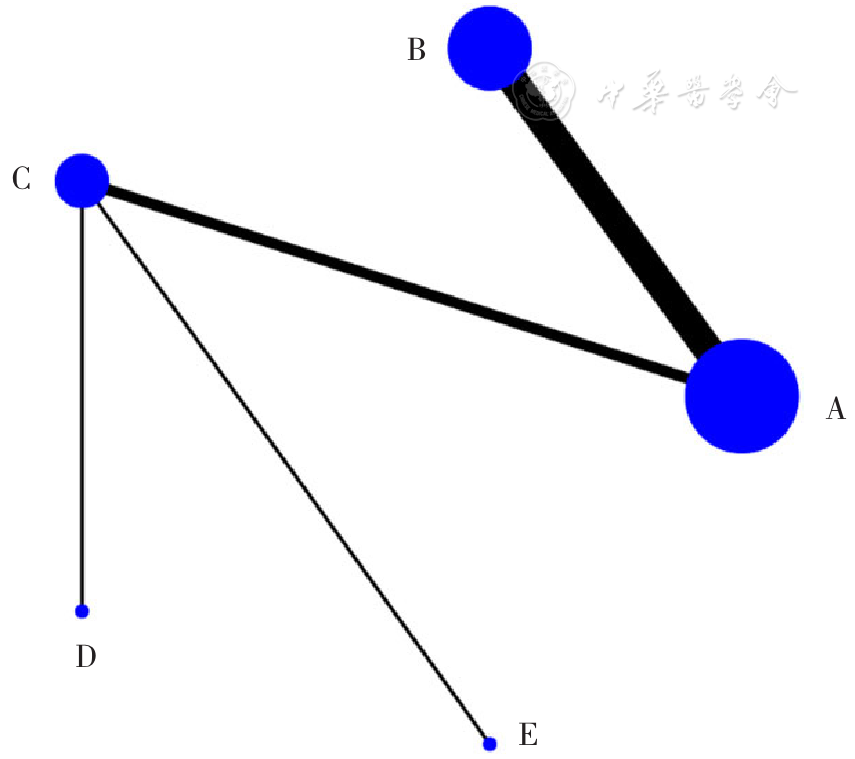
图2 不同干预措施的网状Meta分析经干预胎儿转为头位证据图注:A=常规护理,B=艾灸/刺激至阴穴,C=膝胸卧位,D=艾灸至阴穴+膝胸卧位,E=分娩球运动。
Figure 2 Evidence of using different interventions to move a breech or transverse lie position to a head position from RCTs analyzed by network meta-analysis
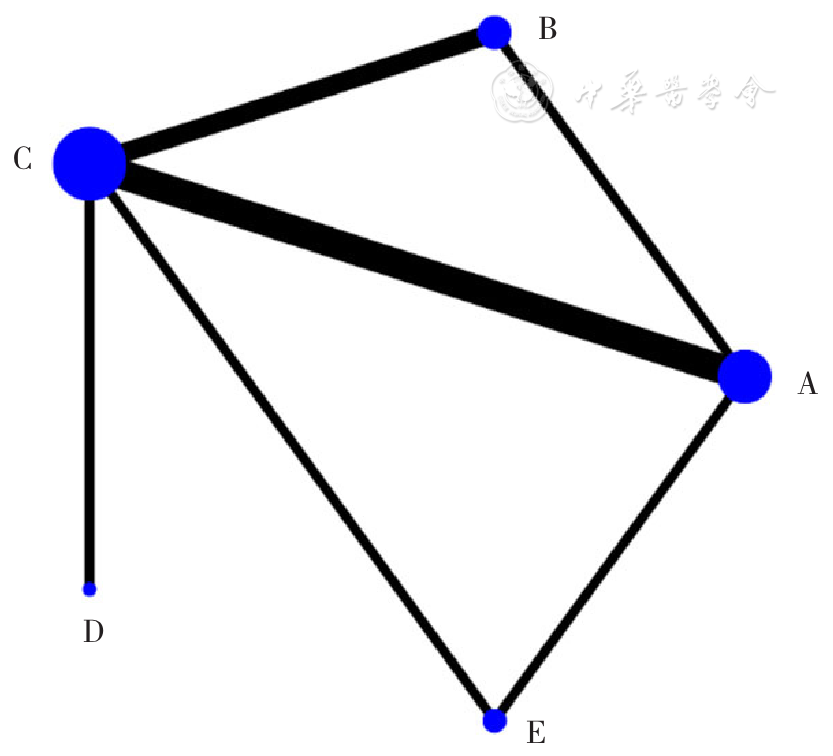
图3 实施ECV前使用不同宫缩抑制剂的网状Meta分析经干预胎儿转为头位证据图注:A=不使用宫缩抑制剂;B=使用钙通道阻滞剂,如硝苯地平;C=使用β2肾上腺素受体激动剂,如沙丁胺醇、利托君、特布他林、非诺特罗;D=使用缩宫素受体拮抗剂,如阿托西班;E=使用一氧化氮供体,如硝酸甘油。
Figure 3 Evidence of using different uterine contraction inhibitors before ECV to move a breech or transverse lie position to a head position from RCTs analyzed by network meta-analysis
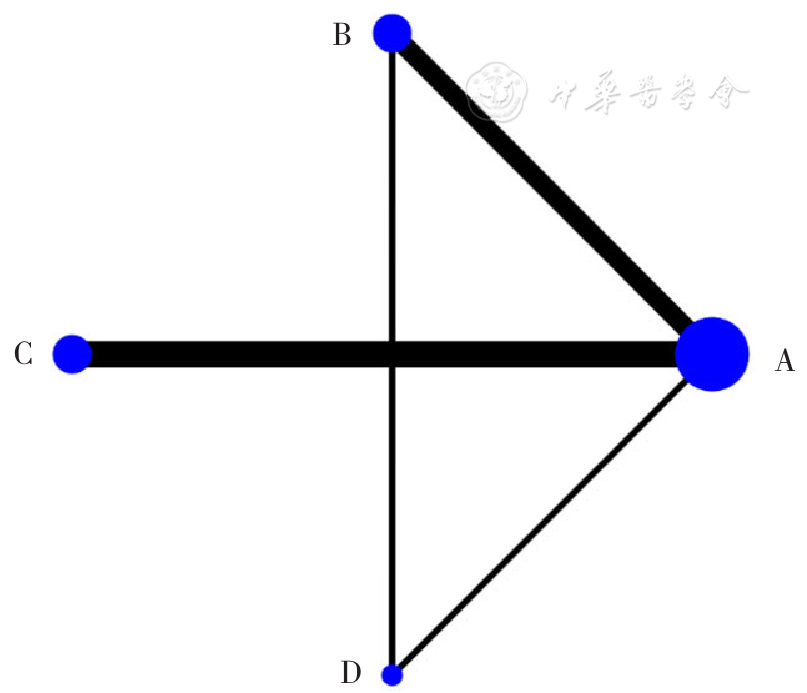
图4 实施ECV中不同麻醉方式的网状Meta分析经干预胎儿转为头位证据图注:A=不麻醉,B=静脉麻醉,C=椎管内麻醉,D=吸入麻醉。
Figure 4 Evidence of using ECV under different types of anesthesia to move a breech or transverse lie position to a head position from RCTs analyzed by network meta-analysis
| 干预措施 | 常规护理 | 艾灸/刺激至阴穴 | 膝胸卧位 | 艾灸至阴穴+膝胸卧位 |
|---|---|---|---|---|
| 艾灸/刺激至阴穴 | 0.54(0.32,0.86) | — | — | — |
| 膝胸卧位 | 1.26(0.52,3.52) | 2.32(0.87,7.54) | — | — |
| 艾灸至阴穴+膝胸卧位 | 0.79(0.18,4.21) | 1.46(0.32,8.62) | 0.64(0.18,2.20) | — |
| 分娩球运动 | 0.82(0.19,4.33) | 1.50(0.33,8.86) | 0.65(0.19,2.27) | 1.03 (0.17,5.96) |
表3 不同干预措施胎儿转为头位成功率比较的网状Meta分析结果〔RR(95%CI)〕
Table 3 Network meta-analysis comparing the success rate of using different interventions to move a breech or transverse lie position to a head position
| 干预措施 | 常规护理 | 艾灸/刺激至阴穴 | 膝胸卧位 | 艾灸至阴穴+膝胸卧位 |
|---|---|---|---|---|
| 艾灸/刺激至阴穴 | 0.54(0.32,0.86) | — | — | — |
| 膝胸卧位 | 1.26(0.52,3.52) | 2.32(0.87,7.54) | — | — |
| 艾灸至阴穴+膝胸卧位 | 0.79(0.18,4.21) | 1.46(0.32,8.62) | 0.64(0.18,2.20) | — |
| 分娩球运动 | 0.82(0.19,4.33) | 1.50(0.33,8.86) | 0.65(0.19,2.27) | 1.03 (0.17,5.96) |
| 干预措施 | 常规护理 | 艾灸/刺激至阴穴 | 膝胸卧位 | 艾灸至阴穴+膝胸卧位 |
|---|---|---|---|---|
| 艾灸/刺激至阴穴 | 0.67(0.36,1.12) | — | — | — |
| 膝胸卧位 | 1.15(0.47,3.00) | 1.73(0.63,5.60) | — | — |
| 艾灸至阴穴+膝胸卧位 | 1.15(0.21,6.80) | 1.72(0.30,11.86) | 1.00(0.23,4.37) | — |
| 分娩球运动 | 0.75(0.13,4.47) | 1.13 (0.19,7.76) | 0.65(0.15,2.91) | 0.66(0.08,5.36) |
表4 不同干预措施阴道分娩率比较的网状Meta分析结果〔RR(95%CI)〕
Table 4 Network meta-analysis comparing the vaginal delivery rate with different interventions
| 干预措施 | 常规护理 | 艾灸/刺激至阴穴 | 膝胸卧位 | 艾灸至阴穴+膝胸卧位 |
|---|---|---|---|---|
| 艾灸/刺激至阴穴 | 0.67(0.36,1.12) | — | — | — |
| 膝胸卧位 | 1.15(0.47,3.00) | 1.73(0.63,5.60) | — | — |
| 艾灸至阴穴+膝胸卧位 | 1.15(0.21,6.80) | 1.72(0.30,11.86) | 1.00(0.23,4.37) | — |
| 分娩球运动 | 0.75(0.13,4.47) | 1.13 (0.19,7.76) | 0.65(0.15,2.91) | 0.66(0.08,5.36) |
| 干预措施 | 常规护理 | 艾灸/刺激至阴穴 |
|---|---|---|
| 艾灸/刺激至阴穴 | 0.69(0.39,1.13) | — |
| 膝胸卧位 | 1.26(0.54,3.06) | 1.83(0.70,5.31) |
表5 不同干预措施头位分娩率比较的网状Meta分析结果〔RR(95%CI)〕
Table 5 Network meta-analysis comparing the cephalic delivery rate with different interventions
| 干预措施 | 常规护理 | 艾灸/刺激至阴穴 |
|---|---|---|
| 艾灸/刺激至阴穴 | 0.69(0.39,1.13) | — |
| 膝胸卧位 | 1.26(0.54,3.06) | 1.83(0.70,5.31) |
| 干预措施 | 经干预胎儿转为头位 | 阴道分娩 | 头位分娩 | |||
|---|---|---|---|---|---|---|
| SUCRA | 秩次 | SUCRA | 秩次 | SUCRA | 秩次 | |
| 常规护理 | 0.365 | 4 | 0.404 | 3 | 0.391 | 2 |
| 艾灸/刺激至阴穴 | 0.843 | 1 | 0.783 | 1 | 0.922 | 1 |
| 膝胸卧位 | 0.186 | 5 | 0.311 | 5 | 0.188 | 3 |
| 艾灸至阴穴+膝胸卧位 | 0.562 | 2 | 0.374 | 4 | — | — |
| 分娩球运动 | 0.544 | 3 | 0.628 | 2 | — | — |
表6 使用不同干预措施纠正臀位/横位效果的网状Meta分析排序概率图表
Table 6 Successful probability of using different interventions to move a breech or transverse lie position to a head position and to deliver vaginally or cephalically in network meta-analysis ranked by SUCRA
| 干预措施 | 经干预胎儿转为头位 | 阴道分娩 | 头位分娩 | |||
|---|---|---|---|---|---|---|
| SUCRA | 秩次 | SUCRA | 秩次 | SUCRA | 秩次 | |
| 常规护理 | 0.365 | 4 | 0.404 | 3 | 0.391 | 2 |
| 艾灸/刺激至阴穴 | 0.843 | 1 | 0.783 | 1 | 0.922 | 1 |
| 膝胸卧位 | 0.186 | 5 | 0.311 | 5 | 0.188 | 3 |
| 艾灸至阴穴+膝胸卧位 | 0.562 | 2 | 0.374 | 4 | — | — |
| 分娩球运动 | 0.544 | 3 | 0.628 | 2 | — | — |
| 干预措施 | 无宫缩抑制剂 | 钙通道阻滞剂 | β2肾上腺素受体激动剂 | 缩宫素受体拮抗剂 |
|---|---|---|---|---|
| 钙通道阻滞剂 | 0.89(0.53,1.41) | — | — | — |
| β2肾上腺素受体激动剂 | 0.60(0.38,0.82) | 0.67(0.41,1.03) | — | — |
| 缩宫素受体拮抗剂 | 0.72(0.31,1.44) | 0.80(0.34,1.75) | 1.19(0.61,2.35) | — |
| 一氧化氮供体 | 0.92(0.47,1.76) | 1.03(0.49,2.26) | 1.55(0.83,3.13) | 1.29(0.53,3.47) |
表7 ECV前使用不同宫缩抑制剂胎儿转为头位成功率比较的网状Meta分析结果〔RR(95%CI)〕
Table 7 Network meta-analysis comparing the success rate of moving a breech or transverse lie position to a head position by use of different uterine contraction inhibitors before ECV
| 干预措施 | 无宫缩抑制剂 | 钙通道阻滞剂 | β2肾上腺素受体激动剂 | 缩宫素受体拮抗剂 |
|---|---|---|---|---|
| 钙通道阻滞剂 | 0.89(0.53,1.41) | — | — | — |
| β2肾上腺素受体激动剂 | 0.60(0.38,0.82) | 0.67(0.41,1.03) | — | — |
| 缩宫素受体拮抗剂 | 0.72(0.31,1.44) | 0.80(0.34,1.75) | 1.19(0.61,2.35) | — |
| 一氧化氮供体 | 0.92(0.47,1.76) | 1.03(0.49,2.26) | 1.55(0.83,3.13) | 1.29(0.53,3.47) |
| 干预措施 | 无宫缩抑制剂 | 钙通道阻滞剂 | β2肾上腺素受体激动剂 | 缩宫素受体拮抗剂 |
|---|---|---|---|---|
| 钙通道阻滞剂 | 1.00(0.60,1.51) | — | — | — |
| β2肾上腺素受体激动剂 | 0.60(0.39,0.89) | 0.60(0.39,0.95) | — | — |
| 缩宫素受体拮抗剂 | 0.67(0.32,1.33) | 0.67(0.33,1.42) | 1.12(0.62,2.01) | — |
| 一氧化氮供体 | 0.64(0.34,1.18) | 0.64(0.32,1.34) | 1.07(0.57,2.03) | 0.95(0.41,2.26) |
表8 ECV前使用不同宫缩抑制剂阴道分娩率比较的网状Meta分析结果〔RR(95%CI)〕
Table 8 Network meta-analysis comparing the vaginal delivery rate with different uterine contraction inhibitors before ECV
| 干预措施 | 无宫缩抑制剂 | 钙通道阻滞剂 | β2肾上腺素受体激动剂 | 缩宫素受体拮抗剂 |
|---|---|---|---|---|
| 钙通道阻滞剂 | 1.00(0.60,1.51) | — | — | — |
| β2肾上腺素受体激动剂 | 0.60(0.39,0.89) | 0.60(0.39,0.95) | — | — |
| 缩宫素受体拮抗剂 | 0.67(0.32,1.33) | 0.67(0.33,1.42) | 1.12(0.62,2.01) | — |
| 一氧化氮供体 | 0.64(0.34,1.18) | 0.64(0.32,1.34) | 1.07(0.57,2.03) | 0.95(0.41,2.26) |
| 干预措施 | 无宫缩抑制剂 | 钙通道阻滞剂 | β2肾上腺素受体激动剂 | 缩宫素受体拮抗剂 |
|---|---|---|---|---|
| 钙通道阻滞剂 | 0.87(0.44,1.66) | — | — | — |
| β2肾上腺素受体激动剂 | 0.52(0.24,1.07) | 0.60(0.29,1.19) | — | — |
| 缩宫素受体拮抗剂 | 0.61(0.21,1.70) | 0.70(0.25,1.91) | 1.16(0.55,2.45) | — |
| 一氧化氮供体 | 0.62(0.25,1.49) | 0.71(0.24,2.13) | 1.18(0.38,3.82) | 1.02(0.26,4.09) |
表9 ECV前使用不同宫缩抑制剂头位分娩率比较的网状Meta分析结果〔RR(95%CI)〕
Table 9 Network meta-analysis comparing the cephalic delivery rate with different uterine contraction inhibitors before ECV
| 干预措施 | 无宫缩抑制剂 | 钙通道阻滞剂 | β2肾上腺素受体激动剂 | 缩宫素受体拮抗剂 |
|---|---|---|---|---|
| 钙通道阻滞剂 | 0.87(0.44,1.66) | — | — | — |
| β2肾上腺素受体激动剂 | 0.52(0.24,1.07) | 0.60(0.29,1.19) | — | — |
| 缩宫素受体拮抗剂 | 0.61(0.21,1.70) | 0.70(0.25,1.91) | 1.16(0.55,2.45) | — |
| 一氧化氮供体 | 0.62(0.25,1.49) | 0.71(0.24,2.13) | 1.18(0.38,3.82) | 1.02(0.26,4.09) |
| 宫缩抑制剂 | 经干预胎儿转为头位 | 阴道分娩 | 头位分娩 | |||
|---|---|---|---|---|---|---|
| SUCRA | 秩次 | SUCRA | 秩次 | SUCRA | 秩次 | |
| 无宫缩抑制剂 | 0.196 | 5 | 0.166 | 5 | 0.138 | 5 |
| 钙通道阻滞剂 | 0.379 | 3 | 0.182 | 4 | 0.298 | 4 |
| β2肾上腺素受体激动剂 | 0.917 | 1 | 0.823 | 1 | 0.821 | 1 |
| 缩宫素受体拮抗剂 | 0.658 | 2 | 0.631 | 3 | 0.616 | 3 |
| 一氧化氮供体 | 0.350 | 4 | 0.698 | 2 | 0.627 | 2 |
表10 ECV前使用不同宫缩抑制剂纠正臀位/横位效果的网状Meta分析排序概率图表
Table 10 Successful probability of using different uterine contraction inhibitors before ECV to move a breech or transverse lie position to a head position and to deliver vaginally in network meta-analysis ranked by SUCRA
| 宫缩抑制剂 | 经干预胎儿转为头位 | 阴道分娩 | 头位分娩 | |||
|---|---|---|---|---|---|---|
| SUCRA | 秩次 | SUCRA | 秩次 | SUCRA | 秩次 | |
| 无宫缩抑制剂 | 0.196 | 5 | 0.166 | 5 | 0.138 | 5 |
| 钙通道阻滞剂 | 0.379 | 3 | 0.182 | 4 | 0.298 | 4 |
| β2肾上腺素受体激动剂 | 0.917 | 1 | 0.823 | 1 | 0.821 | 1 |
| 缩宫素受体拮抗剂 | 0.658 | 2 | 0.631 | 3 | 0.616 | 3 |
| 一氧化氮供体 | 0.350 | 4 | 0.698 | 2 | 0.627 | 2 |
| 干预措施 | 无麻醉 | 静脉麻醉 | 椎管内麻醉 |
|---|---|---|---|
| 静脉麻醉 | 0.71(0.53,0.96) | — | — |
| 椎管内麻醉 | 0.65(0.49,0.85) | 0.91(0.60,1.36) | — |
| 吸入麻醉 | 0.74(0.47,1.18) | 1.04(0.68,1.60) | 1.15(0.68,1.98) |
表11 ECV中不同麻醉方式胎儿转为头位成功率比较的网状Meta分析结果〔RR(95%CI)〕
Table 11 Network meta-analysis comparing the success rate of moving a breech or transverse lie position to a head position by ECV under different anesthesia modes
| 干预措施 | 无麻醉 | 静脉麻醉 | 椎管内麻醉 |
|---|---|---|---|
| 静脉麻醉 | 0.71(0.53,0.96) | — | — |
| 椎管内麻醉 | 0.65(0.49,0.85) | 0.91(0.60,1.36) | — |
| 吸入麻醉 | 0.74(0.47,1.18) | 1.04(0.68,1.60) | 1.15(0.68,1.98) |
| 干预措施 | 无麻醉 | 静脉麻醉 | 椎管内麻醉 |
|---|---|---|---|
| 静脉麻醉 | 0.93(0.50,1.73) | — | — |
| 椎管内麻醉 | 0.77(0.41,1.35) | 0.82(0.34,1.90) | — |
| 吸入麻醉 | 0.87(0.36,2.07) | 0.93(0.39,2.23) | 1.13(0.40,3.36) |
表12 ECV中不同麻醉方式阴道分娩率比较的网状Meta分析结果〔RR(95%CI)〕
Table 12 Vaginal delivery rates intervened by ECV under different anesthesia modes
| 干预措施 | 无麻醉 | 静脉麻醉 | 椎管内麻醉 |
|---|---|---|---|
| 静脉麻醉 | 0.93(0.50,1.73) | — | — |
| 椎管内麻醉 | 0.77(0.41,1.35) | 0.82(0.34,1.90) | — |
| 吸入麻醉 | 0.87(0.36,2.07) | 0.93(0.39,2.23) | 1.13(0.40,3.36) |
| 麻醉方式 | 经干预胎儿转为头位 | 阴道分娩 | ||
|---|---|---|---|---|
| SUCRA | 秩次 | SUCRA | 秩次 | |
| 无麻醉 | 0.036 | 4 | 0.297 | 4 |
| 静脉麻醉 | 0.623 | 2 | 0.438 | 3 |
| 椎管内麻醉 | 0.801 | 1 | 0.724 | 1 |
| 吸入麻醉 | 0.540 | 3 | 0.541 | 2 |
表13 采用不同麻醉方式实施ECV纠正臀位/横位效果的网状Meta分析排序概率图表
Table 13 Successful probability of different anesthesia modes used to move a breech or transverse lie position to a head position and to deliver vaginally in network meta-analysis ranked by SUCRA
| 麻醉方式 | 经干预胎儿转为头位 | 阴道分娩 | ||
|---|---|---|---|---|
| SUCRA | 秩次 | SUCRA | 秩次 | |
| 无麻醉 | 0.036 | 4 | 0.297 | 4 |
| 静脉麻醉 | 0.623 | 2 | 0.438 | 3 |
| 椎管内麻醉 | 0.801 | 1 | 0.724 | 1 |
| 吸入麻醉 | 0.540 | 3 | 0.541 | 2 |
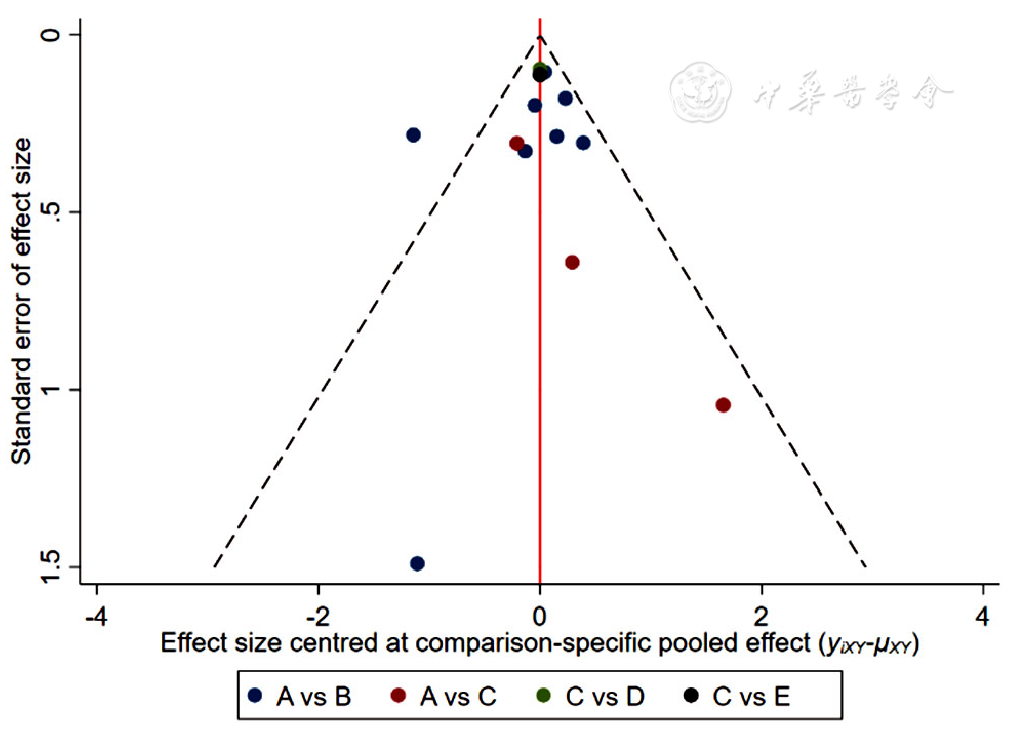
图6 不同干预措施的网状Meta分析经干预胎儿转为头位漏斗图注:A=常规护理,B=艾灸/刺激至阴穴,C=膝胸卧位,D=艾灸至阴穴+膝胸卧位,E=分娩球运动。
Figure 6 Funnel plot assessing the effects of using different interventions to move a breech or transverse lie position to a head position from RCTs in network meta-analysis
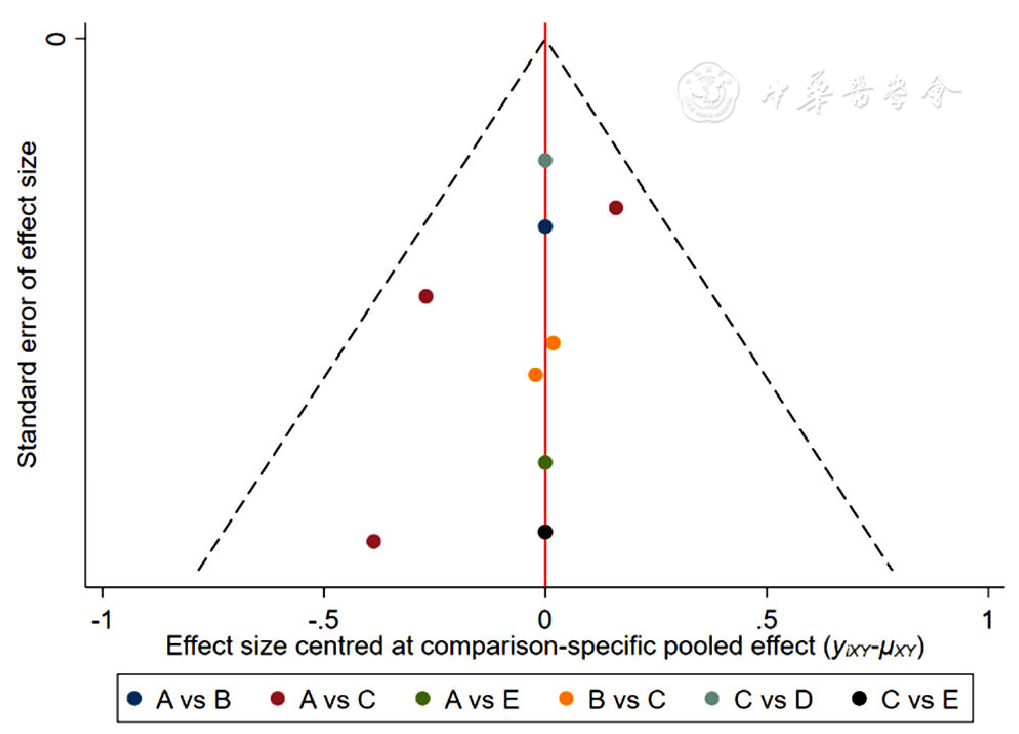
图7 ECV前使用不同宫缩抑制剂的网状Meta分析经干预胎儿转为头位漏斗图注:A=不使用宫缩抑制剂,B=使用钙通道阻滞剂,C=使用β2肾上腺素受体激动剂,D=使用缩宫素受体拮抗剂,E=使用一氧化氮供体。
Figure 7 Funnel plot assessing the effects of using different uterine contraction inhibitors before ECV to move a breech or transverse lie position to a head position from RCTs in network meta-analysis
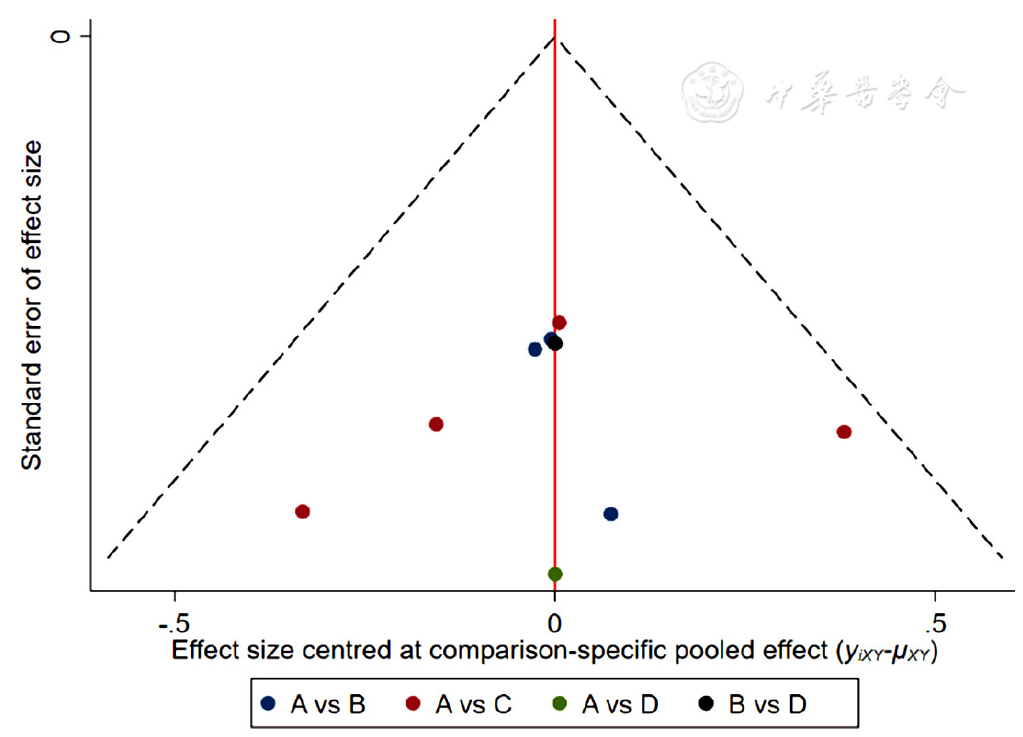
图8 ECV中不同麻醉方式的网状Meta分析经干预胎儿转为头位漏斗图注:A=不麻醉,B=静脉麻醉,C=椎管内麻醉,D=吸入麻醉。
Figure 8 Funnel plot assessing the effects of ECV under different anesthesia methods to move a breech or transverse lie position to a head position from RCTs in network meta-analysis
| [1] |
余艳红,陈叙. 助产学[M]. 北京:人民卫生出版社,2017:324-325.
|
| [2] |
刘兴会,漆洪波. 难产[M]. 2版. 北京:人民卫生出版社,2021:372-377.
|
| [3] |
郭颖婷,翟伟. 艾灸至阴穴矫正胎位不正的系统评价[J]. 实用妇科内分泌电子杂志,2019,6(17):134-135,137. DOI:10.16484/j.cnki.issn2095-8803.2019.17.101.
|
| [4] |
|
| [5] |
|
| [6] |
|
| [7] |
韩春彦,赵存,王兴蕾,等. 13种干预方案治疗脑卒中吞咽困难效果的网状Meta分析[J]. 护理研究,2020,34(11):1869-1877. DOI:10.12102/j.issn.1009-6493.2020.11.001.
|
| [8] |
彭朝梨.臀位外倒转术对足月单胎臀位产妇外倒转成功率及妊娠结局的影响分析[J]. 世界最新医学信息文摘,2021,21(53):149-150. DOI:10.3969/j.issn.1671-3141.2021.53.057.
|
| [9] |
唐小媚,黎箐,杨金菊. 臀位外倒转术对足月单胎臀位产妇外倒转成功率及妊娠结局的影响[J]. 临床医学工程,2020,27(1):55-56. DOI:10.3969/j.issn.1674-4659.2020.01.0055.
|
| [10] |
林岸芸,于红静,武彦,等. 应用分娩球运动纠正胎儿臀先露及改善分娩结局[J]. 实用医学杂志,2020,36(3):406-409. DOI:10.3969/j.issn.1006-5725.2020.03.026.
|
| [11] |
廖琪,孙彦华. 艾灸至阴穴联合膝胸卧位矫正胎儿臀位的临床疗效观察[J]. 当代医学,2018,24(30):141-142.
|
| [12] |
|
| [13] |
|
| [14] |
|
| [15] |
|
| [16] |
|
| [17] |
|
| [18] |
|
| [19] |
|
| [20] |
|
| [21] |
|
| [22] |
|
| [23] |
|
| [24] |
|
| [25] |
|
| [26] |
|
| [27] |
|
| [28] |
|
| [29] |
|
| [30] |
|
| [31] |
|
| [32] |
|
| [33] |
|
| [34] |
|
| [35] |
|
| [36] |
|
| [37] |
|
| [38] |
|
| [39] |
|
| [40] |
|
| [41] |
|
| [42] |
|
| [43] |
|
| [44] |
邓新琼,覃晓慧,廖滔,等. 臀位妊娠矫正方法的研究进展[J]. 广西医学,2017,39(8):1219-1221.
|
| [45] |
|
| [46] |
|
| [47] |
American College of Obstetricians and Gynecologists' Committee on Practice Bulletins——Obstetrics. Practice bulletin no. 161:external cephalic version[J]. Obstet Gynecol,2016,127(2):e54-61. DOI:10.1097/AOG.0000000000001312.
|
| [48] |
|
| [49] |
邓新琼,覃晓慧,廖滔,等. 足月单胎臀位外倒转术的可行性及影响因素分析[J]. 中国妇幼保健,2017,32(11):2476-2479. DOI:10.7620/zgfybj.j.issn.1001-4411.2017.11.72.
|
| [50] |
李海冰,方昕,赵青松,等. 椎管内镇痛对孕妇臀位外倒转术的辅助疗效[J]. 上海交通大学学报(医学版),2016,36(1):89-92. DOI:10.3969/j.issn.1674-8115.2016.01.018.
|
| [1] | 全家霖, 朱琳, 苏煜, 陈泽恺, 陈梓淇, 张卓凡. 运动方式对超重或肥胖儿童青少年执行功能改善效果的网状Meta分析[J]. 中国全科医学, 2025, 28(27): 3422-3431. |
| [2] | 李浩, 李江涛, 刘丹, 王建军. 贝利尤单抗和阿尼鲁单抗及泰它西普治疗系统性红斑狼疮疗效和安全性的网状Meta分析[J]. 中国全科医学, 2025, 28(23): 2924-2933. |
| [3] | 杜琼靓, 林白浪, 郭洪花. 群组育儿保健模式的研究进展及启示[J]. 中国全科医学, 2025, 28(21): 2672-2678. |
| [4] | 何芸, 范焕芳, 马盼, 许绍青, 杨柳, 金明哲, 张明蕊, 陈佳琪. 不同针灸治疗方式干预乳腺癌术后上肢淋巴水肿效果的网状Meta分析[J]. 中国全科医学, 2025, 28(14): 1788-1794. |
| [5] | 朱胜杰, 刁华琼, 杭晓屹, 孙文军. 不同中成药注射液治疗后循环缺血性眩晕效果的网状Meta分析[J]. 中国全科医学, 2025, 28(14): 1795-1808. |
| [6] | 迟洵, 刘思思, 陈巧, 胡玥, 王伟仙. 不同营养筛查工具对肝硬化患者营养筛查适用性的网状Meta分析[J]. 中国全科医学, 2025, 28(11): 1395-1402. |
| [7] | 谷明宇, 秦廷廷, 乔昆, 白欣苑, 王尧, 杨宇彤, 李星明. 中国基层高血压管理模式的网状Meta分析[J]. 中国全科医学, 2025, 28(10): 1265-1272. |
| [8] | 郭佳, 曹春梅, 刘国纯, 郑满, 朱芮含, 龙伟. 不同运动方式对失眠患者睡眠影响效果的网状Meta分析[J]. 中国全科医学, 2024, 27(35): 4376-4387. |
| [9] | 黄腾佳, 曹曦, 陈蕾, 李子滢, 秦莉花. 非药物治疗脑卒中后肩手综合征有效性的网状Meta分析[J]. 中国全科医学, 2024, 27(23): 2921-2930. |
| [10] | 王婷, 王海燕, 富文俊. 不同针灸疗法治疗慢性萎缩性胃炎效果的网状Meta分析[J]. 中国全科医学, 2024, 27(23): 2913-2920. |
| [11] | 香钰婷, 曾带娣, 欧宜静, 黄丽珊, 陈文婷, 吴婉华, 萧丽娟, 李仲均. 结合修正版Robson分类系统对新生育政策下经产妇剖宫产现状的回顾性研究[J]. 中国全科医学, 2024, 27(18): 2205-2211. |
| [12] | 谭书法, 张磊昌, 高强强, 欧艳, 黄水兰. 生物制剂和小分子药物治疗溃疡性结肠炎有效性与安全性的网状Meta分析[J]. 中国全科医学, 2024, 27(17): 2155-2166. |
| [13] | 牛靖元, 陈会生, 于嘉祥, 崔钰. 川芎嗪类注射液辅助治疗急性缺血性脑卒中疗效的贝叶斯网状Meta分析[J]. 中国全科医学, 2024, 27(14): 1761-1774. |
| [14] | 徐俊, 齐文杰, 王超, 胡岚, 苗彬. 不同病因妊娠合并急性胰腺炎患者的临床特征及母婴预后研究[J]. 中国全科医学, 2024, 27(11): 1343-1348. |
| [15] | 何静漪, 王芳, 税晓玲, 李玲, 梁倩. 非药物干预改善围绝经期失眠症状疗效的网状Meta分析[J]. 中国全科医学, 2023, 26(31): 3963-3974. |
| 阅读次数 | ||||||
|
全文 |
|
|||||
|
摘要 |
|
|||||





